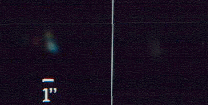


Shown above is what I believe to be the first color photo ever taken of the diffraction pattern of a real star! The photo was taken with the AO-2 adaptive optics system, proving the advantage of image stabilization, even on nights of good seeing! The image was scanned from an original enlargement made from the negative, so there is quite a bit of detail missing. The right hand photo shows the same star, but with the AO-2 turned off. You may have to turn up your monitor brightness, but there is a smudge! Here is the description and story behind the image pair.
On February 5, 1993, Colorado Springs had a rare night of pretty good seeing. Capella (a Aurigae) was nearly overhead, and using high power magnification, I could see some misalignment in the 8" SCT I was using. The diffraction pattern was comatic, but from previous experience, I knew I could remove most of the distortion with proper alignment. Where do you go to get an alignment tool at 11 p.m. on a Friday night when you can't find your old one?! I had to take photos as-is, and hope the good seeing would be repeated the next night (it wasn't).
Through the eyepiece, the first and second rings were not complete, and were undulating and broken. The central Airy disk was fairly well defined. On Kodak Ektar 25 film, chosen for its microfine grain, I took several 9 second exposures with eyepiece projection to give about F/170. The long exposures were required to image the fainter patterns I could see visually. The central Airy disk is relatively overexposed on the print, but the elliptical color pattern is obvious. While I initially assumed the color fringing in the central disk was due to the instrument coma, raytraces don't make that obvious. I believe now that its color is due to atmospheric refraction. Even though the star was only about 20 degrees from the zenith, my calculations show the red-blue dispersion should be about ¼ arcseconds, which matches the spread in the photo! (At sea level, the dispersion would have been about 0.4 arcseconds.)
The source of telescope misalignment has also been determined. In the cold February weather, the grease inside the 8" SCT was considerably more viscous, and the primary mirror tilted substantially during focus. Without compensating for backlash, the measured image movement (due to a change in the focus direction) at the prime focus was about 4 mm. Inserting this into a raytracing program shows just about the coma measured on the photograph! During warmer months, the image motion is considerably less, and collimation is easier to maintain. The outer "fringes" in the Capella photo are also colored, probably due to the wavelength dependence of the diffraction effect and the colored scintillation in the rings themselves. I haven't investigated this fine structure any further. Note the AO-2 adaptive optics system corrects for average motion, not the subaperture fine structure.
The alternate exposures with the AO-2 turned "off" show a simple bulge, centered on the star. No detail is visible, and the larger, wandered image is dimmer. Upon analysis, the diameter of the first dark "ring" surrounding the Airy disk in the photo calculates to the theoretical diameter of 2.44 l /D = 6.61 microradians = 1.36 arcsec (using 0.55 micron wavelength). The long exposure didn't hurt the resolution too much, indicating stabilization to an estimated less than about 1/4 arcsecond. Most of the major planets, the intended targets for the AO-2 are brighter than Capella, giving potentially better performance.
All text and images are owned by Stellar Products, 1992-2003. Any use by others without permission of Stellar Products is prohibited.
Return to the Image Gallery index page
Return to Stellar Products home page